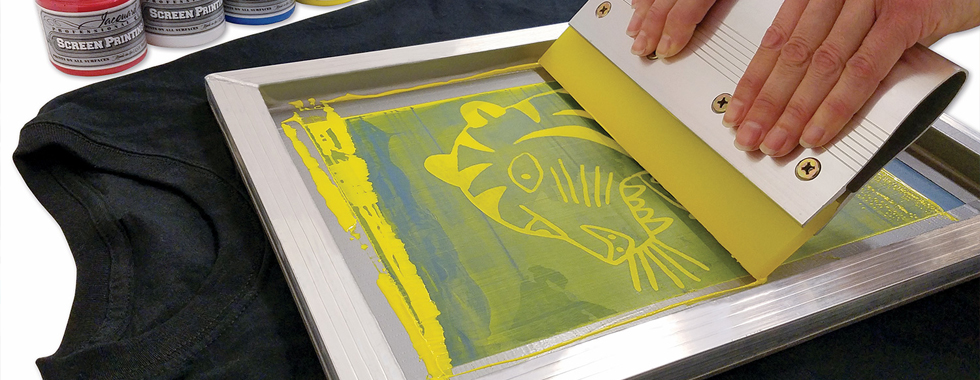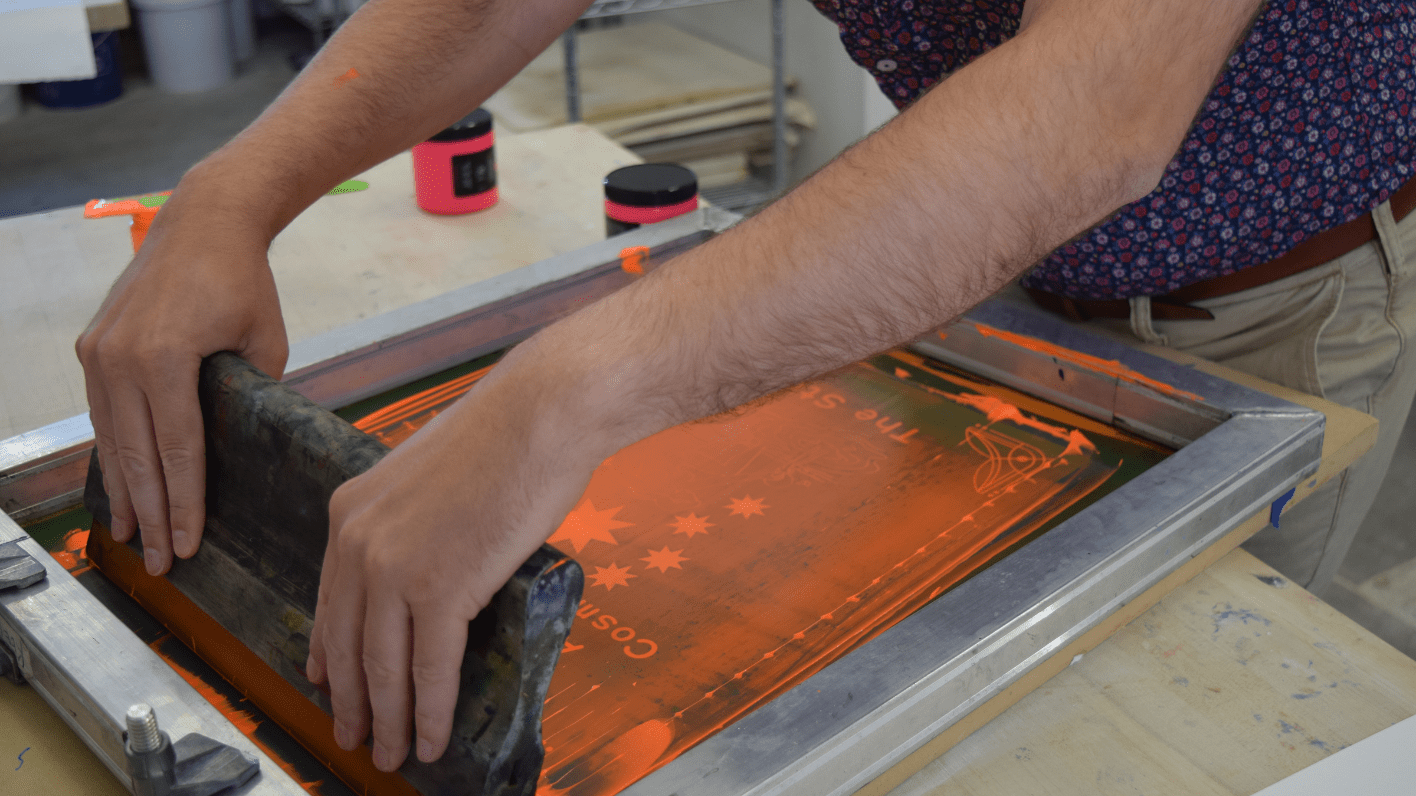From Style to Delivery: Understanding the Art of T-Shirt Screen Printing
The trip from style to distribution in t-shirt screen printing encompasses a series of critical stages that demand attention to detail and calculated planning. It begins with recognizing the nuances of your target audience, complied with by the option of suitable products and the prep work of artwork that meets high standards. Yet, as the procedure unravels, obstacles in high quality control and logistics can develop, possibly influencing the last result. Checking out these intricacies exposes not only the details of screen printing but additionally the essential techniques that can elevate a brand's standing in a competitive market.
Comprehending T-Shirt Screen Printing
Comprehending T-Shirt screen printing involves acknowledging a versatile and widely made use of approach for moving styles onto material. This method uses a mesh and a stencil screen to apply ink onto different textile materials, mainly cotton and polyester blends. The procedure starts with the creation of a display that includes the preferred style, which is after that carefully aligned on the material.
Ink is pushed with the screen's open locations making use of a squeegee, enabling specific application of shade. This method is favored for its capability to produce vibrant, lasting prints that hold up well to cleaning and use. Additionally, screen printing is capable of accommodating both complicated and easy layouts, making it a preferred choice for custom garments, advertising items, and also creative works.
Moreover, screen printing uses scalability, making it suitable for both tiny batch orders and massive manufacturings. While initial configuration costs may be greater compared to other printing techniques, the performance and toughness of screen printing typically justify the financial investment. On the whole, recognizing the basics of Tee shirts screen printing is vital for anybody aiming to take part in this prominent kind of material decor, whether for commercial endeavors or personal projects.
Conceiving Your Design
Conceiving your design is an essential action in the Tee shirts screen printing process, as it sets the structure for the entire project (Business Branding Services). This phase involves generating ideas that resonate with your target audience while ensuring that the design straightens with the brand name's identification and message. It is necessary to start by exploring themes, color pattern, and graphics that reflect the intended aesthetic
Sketching initial concepts can be helpful, permitting a visual representation of concepts before finalizing the design. Think about the usage of typography, images, and design in such a way that catches interest and interacts efficiently. Additionally, it is important to anticipate the printing method that will certainly be used, as this can affect design intricacy and shade options.
Engaging in brainstorming sessions with staff member or looking for feedback from potential customers can also improve the conceptualization process, providing diverse point of views that improve the layout. Ultimately, a well-thought-out layout not just improves the aesthetic allure of the Tees however also fosters a link with the target market, driving rate of interest and potential sales. As a result, committing time to conceptualize your layout can result in a successful screen printing outcome.
Picking the Right Materials

The weight of the fabric, usually measured in grams per square meter (GSM), influences the drape and general feel of the T-shirt. Larger textiles might supply a more exceptional appearance, while lighter options fit for sportswear. Texture additionally contributes; smoother textiles tend to yield sharper prints, while distinctive surfaces can create special aesthetic impacts.
Furthermore, consider the environmental impact of products. Organic cotton and recycled polyester are acquiring popularity amongst eco-conscious consumers. Inevitably, choosing the appropriate products includes stabilizing aesthetic allure, capability, and sustainability, ensuring that the Tee shirts not only looks wonderful however additionally satisfies the assumptions of your target market.
Preparing Artwork for Printing
Preparing art work for T-shirt screen printing calls for careful focus to detail to ensure that the final print accurately mirrors the desired layout. The initial step is to develop a high-resolution electronic documents, ideally in vector format, as this enables scalability without loss of top quality. Common software application used for this objective consists of Adobe Illustrator and CorelDRAW.
Next, verify that all message is converted to lays out or rasterized to prevent font concerns during printing (Custom T-Shirt Design & Printing Texas). Additionally, it is vital to validate that the color setting is set to CMYK, as this aligns with the printing procedure. Pay attention to shade matching; making use of Pantone colors can help attain uniformity across different prints
Take into consideration the dimensions of the print area and preserve appropriate margins to prevent style cutoff. It's additionally sensible to include registration marks for placement throughout the printing process. Business Branding Services. Demand a proof from the printer to visualize the final product before mass production. This action is essential for determining any kind of potential problems, assuring that the printed T-shirt satisfies the wanted top Learn More Here quality and layout specifications. Appropriate preparation of art work substantially affects the total success of the screen printing task
Grasping the Printing Process
Understanding the printing procedure is important for attaining top notch lead to T-shirt screen printing. This stage involves several substantial steps that directly affect the end product. The primary step is establishing the printing machine properly. Appropriate registration of screens guarantees that shades align appropriately, protecting against misprints and guaranteeing an expert appearance.
Next off, choosing the appropriate ink is very important. Various ink types, such as plastisol or water-based, deal various surfaces and toughness. Recognizing the textile composition of the Tee shirts additionally helps in choosing compatible inks.
When it concerns the real printing, controlling the squeegee stress and angle is vital. Constant stress will yield also ink circulation, while the angle affects the flow and coverage. In addition, changing the rate of the printing machine can influence the ink's treating process, which is basic for ensuring resilience.
Quality Assurance and Finishing
After the printing process is complete, implementing efficient quality assurance actions becomes important to validate that each Tees fulfills the wanted requirements. Quality assurance involves a systematic strategy to checking each garment for defects, verifying that the print top quality, color accuracy, and textile stability straighten with the specifications set during the design phase.

The primary step in quality assurance is a comprehensive visual inspection. This entails checking for typical problems such as imbalance, ink spots, or fading. Any type of T-shirt that does not satisfy the high quality benchmarks need to be resolved immediately, either via reprinting or fixing.
In enhancement to visual checks, it is very important to conduct wash examinations on a sample of printed t-shirts to assess the durability of the inks and the total durability of the layout. These examinations assist confirm that the print will preserve its vibrancy and integrity after numerous washes, a crucial element for client contentment.
Finishing touches, such as thread cutting and the application of care tags, additionally play a considerable duty in quality assurance - T-Shirt Printing. By focusing on these facets, organizations can improve the overall discussion of their items, eventually leading to a much more rewarding consumer experience
Product Packaging and Distribution Solutions

To accomplish suitable packaging, consider using environment-friendly materials that align with sustainability fads, such as recyclable poly bags or eco-friendly boxes. Each Tee shirts should be neatly folded up and put in safety wrapping to stop creasing and possible damage throughout transportation. Including a well-known insert or treatment instructions can better customize the experience, fostering consumer loyalty.
Selecting a reliable delivery companion is essential when it comes to shipment. Examine alternatives based upon rate, monitoring, and expense capabilities. Offering several delivery approaches can cater to various client demands, from conventional to expedited delivery.
Regularly Asked Questions
What Are the Usual Mistakes Novices Make in Screen Printing?
Usual mistakes beginners make in screen printing consist of incorrect screen prep work, poor ink mixing, incorrect exposure times, not enough curing, and ignoring to examine prints. These mistakes can result in low quality and unsatisfactory results in end products.
Just How Can I Avoid Ink From Bleeding Throughout Printing?
To protect against ink blood loss throughout printing, guarantee correct screen tension, usage appropriate solution density, pick the ideal ink uniformity, maintain optimal treating temperature levels, and stay clear of overloading the screen with too much ink throughout application.
What Sorts of Inks Are Finest for Different Fabrics?
Picking inks based upon textile kind is essential. Water-based inks are perfect for cotton, giving gentleness. Plastisol inks match synthetic materials, supplying sturdiness. Release inks successfully mix with natural fibers, guaranteeing lively colors without endangering fabric integrity.
Exactly how Do I Pick the Right Screen Mesh Matter?
Picking the appropriate screen mesh matter depends upon the preferred print detail and ink kind. Abilene T-Shirt Screen Printing Company. Higher mesh counts generate better information, while lower counts promote thicker inks. Analyze material type and layout intricacy for suitable results
Can I Use Screen Printing for Little Batch Orders?
Yes, screen printing can be successfully used for small set orders. This technique enables in-depth styles and premium results, making it a viable alternative for customized apparel, advertising things, or restricted edition runs.
Recognizing T-Shirt screen printing includes acknowledging a flexible and widely utilized technique for transferring layouts onto fabric. While first setup costs might be greater compared to other printing approaches, the efficiency and sturdiness of screen printing frequently justify the investment. Preparing art work for T-shirt screen printing needs cautious interest to information to ensure that the final print properly reflects the desired style. Grasping the printing process is crucial for attaining high-quality outcomes in Tees screen printing. Typical mistakes beginners make in screen printing include inappropriate screen prep work, insufficient ink mixing, incorrect exposure times, not enough healing, and ignoring to test prints.